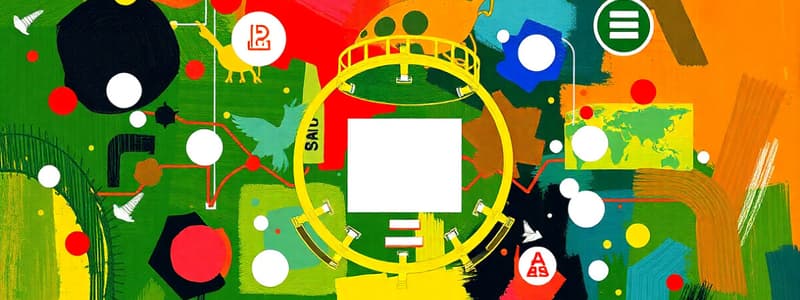Podcast
Questions and Answers
What is the primary focus of resource optimization in an IT infrastructure?
What is the primary focus of resource optimization in an IT infrastructure?
- Ensuring an integrated, economical IT infrastructure (correct)
- Maximizing the physical space for IT equipment
- Eliminating the use of obsolete technology completely
- Reducing costs associated with hiring staff
Which of the following is a key element of resource optimization?
Which of the following is a key element of resource optimization?
- Isolating IT personnel from other departments
- Focusing solely on hardware improvements
- Minimizing the training provided to staff
- Exploiting data and information for optimal value (correct)
Who is primarily responsible for risk governance in most enterprises?
Who is primarily responsible for risk governance in most enterprises?
- External auditors and consultants
- The IT department manager
- The board of directors and chairperson (correct)
- All employees equally
What does effective risk governance ensure regarding stakeholder needs?
What does effective risk governance ensure regarding stakeholder needs?
Which of the following describes a responsibility of the risk management function within effective risk governance?
Which of the following describes a responsibility of the risk management function within effective risk governance?
What is one of the four main objectives of risk governance as described?
What is one of the four main objectives of risk governance as described?
How does good risk governance influence decision-making within an enterprise?
How does good risk governance influence decision-making within an enterprise?
Which aspect does risk governance prioritize for effective decision-making?
Which aspect does risk governance prioritize for effective decision-making?
What aspects are included in the full value chain of an enterprise?
What aspects are included in the full value chain of an enterprise?
How should the risk landscape be logically segmented?
How should the risk landscape be logically segmented?
What is essential for aligning strategic planning with risk identification?
What is essential for aligning strategic planning with risk identification?
Why is regular reviewing and updating of the risk universe necessary?
Why is regular reviewing and updating of the risk universe necessary?
How does the geopolitical environment influence the risk universe?
How does the geopolitical environment influence the risk universe?
What primary role does the risk governance function play in business decisions?
What primary role does the risk governance function play in business decisions?
How does the governing board contribute to effective risk management?
How does the governing board contribute to effective risk management?
What essential distinction differentiates governance from management?
What essential distinction differentiates governance from management?
What is a key component of effective risk management?
What is a key component of effective risk management?
Which statement correctly describes the aim of risk management?
Which statement correctly describes the aim of risk management?
What may happen if an enterprise is well-managed but poorly governed?
What may happen if an enterprise is well-managed but poorly governed?
Which segment of the risk management process is primarily overseen by managers?
Which segment of the risk management process is primarily overseen by managers?
What characteristic is essential for accurately addressing risk circumstances?
What characteristic is essential for accurately addressing risk circumstances?
What is a critical benefit of using Key Risk Indicators (KRIs) in risk governance?
What is a critical benefit of using Key Risk Indicators (KRIs) in risk governance?
How should management demonstrate support for risk practices according to best practices?
How should management demonstrate support for risk practices according to best practices?
What is indicated by risk indicators falling outside of the accepted risk appetite?
What is indicated by risk indicators falling outside of the accepted risk appetite?
What role do stakeholders play in the risk governance framework?
What role do stakeholders play in the risk governance framework?
Which statement reflects proper alignment of risk management practices?
Which statement reflects proper alignment of risk management practices?
What is a necessary component for effective monitoring of risk and progress?
What is a necessary component for effective monitoring of risk and progress?
What is an expected outcome of aligning risk-adjusted revenue with management expectations?
What is an expected outcome of aligning risk-adjusted revenue with management expectations?
What is the primary purpose of obtaining genuine commitments from personnel in risk management?
What is the primary purpose of obtaining genuine commitments from personnel in risk management?
What is one key benefit of effective risk communication in an enterprise?
What is one key benefit of effective risk communication in an enterprise?
What consequence may result from poor risk communication within an enterprise?
What consequence may result from poor risk communication within an enterprise?
Which of the following is NOT a benefit of open communication on risk?
Which of the following is NOT a benefit of open communication on risk?
What aspect of risk management is crucial for ensuring proper reporting of risks?
What aspect of risk management is crucial for ensuring proper reporting of risks?
How does poor risk communication affect external stakeholders?
How does poor risk communication affect external stakeholders?
What should be included in expectations from risk management communication?
What should be included in expectations from risk management communication?
What is a result of a blame culture identified in executive leadership?
What is a result of a blame culture identified in executive leadership?
What must happen first for risk to be effectively managed and mitigated?
What must happen first for risk to be effectively managed and mitigated?
What is one main objective of the change management policy?
What is one main objective of the change management policy?
Which element is NOT included in the delegation of authority policy?
Which element is NOT included in the delegation of authority policy?
What does the whistle-blower policy primarily aim to provide?
What does the whistle-blower policy primarily aim to provide?
The internal control policy is designed to accomplish what?
The internal control policy is designed to accomplish what?
Which policy addresses risks related to intellectual property in IT-related creative endeavors?
Which policy addresses risks related to intellectual property in IT-related creative endeavors?
What key principle is contained within the delegation of authority policy?
What key principle is contained within the delegation of authority policy?
The internal control policy aims to reduce exposure to all risks faced by the enterprise. What is an essential aspect of this policy?
The internal control policy aims to reduce exposure to all risks faced by the enterprise. What is an essential aspect of this policy?
Which of the following best describes the intent of the change management policy?
Which of the following best describes the intent of the change management policy?
How does the whistle-blower policy intend to support employees?
How does the whistle-blower policy intend to support employees?
What is a primary focus of the internal controls established by the internal control policy?
What is a primary focus of the internal controls established by the internal control policy?
Flashcards
Risk Governance
Risk Governance
The process of overseeing and ensuring that an organization follows its risk management plans and that controls are effective in mitigating risks.
Risk Management
Risk Management
A formal process designed to identify, assess, and manage potential risks that could impact an organization's ability to achieve its objectives.
Risk Awareness
Risk Awareness
The ability to anticipate and respond to challenges that could prevent an organization from achieving its goals.
Risk Mitigation
Risk Mitigation
Signup and view all the flashcards
Risk Control
Risk Control
Signup and view all the flashcards
Risk Monitoring
Risk Monitoring
Signup and view all the flashcards
Risk Opportunity
Risk Opportunity
Signup and view all the flashcards
Risk Consequence
Risk Consequence
Signup and view all the flashcards
Resource Optimization
Resource Optimization
Signup and view all the flashcards
Risk Culture
Risk Culture
Signup and view all the flashcards
Risk-Aware Business Decisions
Risk-Aware Business Decisions
Signup and view all the flashcards
Effective Risk Management Function
Effective Risk Management Function
Signup and view all the flashcards
Evaluating Stakeholder Needs
Evaluating Stakeholder Needs
Signup and view all the flashcards
Direction Setting Through Prioritization
Direction Setting Through Prioritization
Signup and view all the flashcards
Monitoring Progress Against Objectives
Monitoring Progress Against Objectives
Signup and view all the flashcards
Risk Universe
Risk Universe
Signup and view all the flashcards
Enterprise Value Chain
Enterprise Value Chain
Signup and view all the flashcards
Risk Segmentation
Risk Segmentation
Signup and view all the flashcards
Dynamic Risk Management
Dynamic Risk Management
Signup and view all the flashcards
Risk-Informed Strategic Planning
Risk-Informed Strategic Planning
Signup and view all the flashcards
Using KRIs as an early warning system
Using KRIs as an early warning system
Signup and view all the flashcards
Engaging Stakeholders to Agree on Actions
Engaging Stakeholders to Agree on Actions
Signup and view all the flashcards
Obtaining Commitment and Resources
Obtaining Commitment and Resources
Signup and view all the flashcards
Aligning Policies and Actions to Risk Appetite
Aligning Policies and Actions to Risk Appetite
Signup and view all the flashcards
Monitoring Progress Against Action Plans
Monitoring Progress Against Action Plans
Signup and view all the flashcards
Understanding Risk from a Portfolio View
Understanding Risk from a Portfolio View
Signup and view all the flashcards
Risk-Based Decision Making
Risk-Based Decision Making
Signup and view all the flashcards
A Culture of Risk Management
A Culture of Risk Management
Signup and view all the flashcards
Change management policy
Change management policy
Signup and view all the flashcards
Delegation of authority policy
Delegation of authority policy
Signup and view all the flashcards
Whistle-blower policy
Whistle-blower policy
Signup and view all the flashcards
Internal control policy
Internal control policy
Signup and view all the flashcards
Intellectual property (IP) policy
Intellectual property (IP) policy
Signup and view all the flashcards
Risk Communication
Risk Communication
Signup and view all the flashcards
False Sense of Confidence
False Sense of Confidence
Signup and view all the flashcards
Lack of Risk Management Strategy
Lack of Risk Management Strategy
Signup and view all the flashcards
Unbalanced Communication of Risk
Unbalanced Communication of Risk
Signup and view all the flashcards
Perception of Hiding Risk
Perception of Hiding Risk
Signup and view all the flashcards
Risk Appetite
Risk Appetite
Signup and view all the flashcards
Clear Lines of Communication
Clear Lines of Communication
Signup and view all the flashcards
Study Notes
Risk Governance and Management
- Stakeholder needs, conditions, and options are evaluated to determine balanced enterprise objectives.
- Direction is set through prioritization and decision-making.
- Performance, compliance, and progress are monitored against agreed-on direction and objectives.
- In most enterprises, the board of directors, under the leadership of the chairperson, is responsible for overall risk governance.
- Specific governance responsibilities may be delegated to special enterprise structures, especially in complex enterprises.
Governance Objectives
- The objective of any governance system is to enable an enterprise to create value for its stakeholders or promote value creation.
- Value creation comprises benefits realization, risk optimization, and resource optimization.
Benefits Realization
- Benefits realization involves creating value for the enterprise through I&T, maintaining and increasing value from existing IT investments, and eliminating initiatives and assets that don't create sufficient value.
- IT value delivery delivers fit-for-purpose services and solutions on time, within budget, and generating intended financial and non-financial benefits.
- The value of IT investments should be directly aligned with business values and measured to show their impact and contribution.
Risk Optimization
- Risk optimization addresses business risks associated with IT use, ownership, operation, involvement, and adoption.
- I&T-related business risk consists of events that could potentially impact the business. Value preservation is as important as value creation.
- Risk management should be integrated within the enterprise risk management approach to ensure I&T risk is considered.
- Optimal IT-related risk management is essential and cannot be isolated from other governance aspects.
Resource Optimization
- Resource optimization ensures the availability of appropriate capabilities and resources to execute the strategic plan.
- Resource optimization provides integrated, economical IT infrastructure, introduces new technology as needed by the business, and updates or replaces obsolete systems.
Risk Governance Objectives
- Risk governance sets the direction and strategy for risk management efforts and defines acceptable levels of risk.
- Risk governance ensures effective risk identification, management, monitoring, and reporting on current and potential enterprise risks.
- Stakeholder needs, conditions, and options are evaluated to establish balanced, agreed-on enterprise objectives for achievement.
Risk Management
- Risk management is a coordinated activity for the direction and control of an enterprise regarding risk.
- Risk is viewed as a challenge to achieving objectives, and risk management predicts and lowers risks.
- Effective risk management can aid in maximizing opportunities (potential benefits).
- Risk management's dual nature is present in various contexts within business and IT, making a clear distinction challenging.
- Risk management starts with understanding the enterprise, environment, and: potential threats, capabilities, relative values of assets/resources, and established trust.
I&T Risk Governance and Management
- I&T risk governance and management implements a risk strategy reflecting enterprise management's culture, appetite, and tolerance levels.
- An effective I&T risk management strategy facilitates smooth execution of overall business strategy.
- It connects I&T-related risk management to business or mission objectives, aligning I&T risk management with enterprise risk management (ERM).
- It balances the costs and benefits of managing I&T-related risk according to analysis of alternatives and prioritization, addressing potential impact on enterprise objectives.
Enterprise Risk Management Alignment
- Enterprise governance of I&T-related risk aligns with overarching enterprise risk management (ERM).
- Decisions consider the full range of potential consequences of I&T-related risk.
- I&T-related risk assessment is coordinated across the enterprise.
Cost and Benefit Balance
- I&T-related risk prioritization and management align with risk tolerance and appetite.
- Risk responses are based on cost/benefit analysis, considering alternatives and prioritization of risks based on enterprise objectives.
Ethical and Open Communication
- I&T-related risk management promotes ethical and open communication.
- Risk information is exchanged freely and openly, fostering accuracy, timeliness, and transparency.
- Risk culture and management methods are integrated across the enterprise, and communication is in understandable terms.
Establish Tone at the Top and Accountability
- Business owners, the board, and executive leadership are engaged in risk management.
- Risk ownership is clear and accountability is assigned.
- Risk-aware culture and personal responsibility are fostered. Risk-informed decisions are based on tolerances.
Risk Management Workflow
- Risk identification, assessment, analysis, mitigation, monitoring, and reporting are key risk management steps.
- The process repeats as the risk environment changes (internal/external factors).
Core Risk Policy Types
- Core IT risk policy defines how risk is governed and managed based on enterprise objectives.
- Information security policies define behavior for information's protection, and security and storage are addressed.
- Crisis management policies outline procedures for crisis situations, addressing operational risk and third-party service management.
- Business continuity policies deal with recovery requirements for critical systems and disaster recovery plans.
- Program/project management policies address project management, including risk analysis, reporting, and mitigating adverse events.
- Fraud risk policies cover procedures for handling fraud and misconduct.
- Other specific policies exist for compliance, ethics, quality, service management, change management, whistle-blower protection, internal controls, and intellectual property.
Risk Scoping
- Risk scoping focuses on specific areas for risk management within the enterprise's full risk universe.
- Risk scoping clarifies which parts of the enterprise that will be addressed through risk management.
- Enterprise risk scoping can be periodic (annual) for stable environments.
- Major stakeholders should be involved in the scoping exercise.
Studying That Suits You
Use AI to generate personalized quizzes and flashcards to suit your learning preferences.




